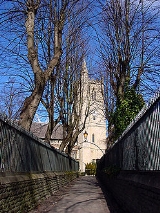
St James' Priory, Bristol
Encyclopedia
The Priory Church of St James, Bristol
http://www.wikimapia.org/#lat=51.458605&lon=-2.593044&z=20&l=0&m=h&v=2 is a Grade I listed building in Horsefair, Whitson Street.
It was founded in 1129 as a Benedictine
priory
by Robert
, Earl of Gloucester
, the illegitimate son of Henry I
. The nave survives from 1129 but the tower was added around 1374. The south aisle was widened and rebuilt in 1698. The porch dates from the late 18th century, and the north aisle was rebuilt in 1864.
Legend has it that every 10th stone brought from Normandy to build the Castle was set aside to build the Priory, and therefore ‘now that the castle has vanished these stones are like an echo from 800 years ago.’
The building is on the English Heritage
Buildings at Risk Register and described as being in very bad condition.
. The last fair was held in 1837. It also subsequently left its mark on the geography of Bristol as a nearby road in Broadmead is called the Horsefair.
, the nave of the priory church continued in use as an Anglican parish church. It fell into disuse in the 1980s but in 1996 the Little Brothers of Nazareth re-established it as a Catholic church, and set up the St James Priory Project (http://www.stjamesprioryproject.org.uk) which offers comprehensive support to people with a history of homelessness who have a substance
dependency.
Bristol
Bristol is a city, unitary authority area and ceremonial county in South West England, with an estimated population of 433,100 for the unitary authority in 2009, and a surrounding Larger Urban Zone with an estimated 1,070,000 residents in 2007...
http://www.wikimapia.org/#lat=51.458605&lon=-2.593044&z=20&l=0&m=h&v=2 is a Grade I listed building in Horsefair, Whitson Street.
It was founded in 1129 as a Benedictine
Benedictine
Benedictine refers to the spirituality and consecrated life in accordance with the Rule of St Benedict, written by Benedict of Nursia in the sixth century for the cenobitic communities he founded in central Italy. The most notable of these is Monte Cassino, the first monastery founded by Benedict...
priory
Priory
A priory is a house of men or women under religious vows that is headed by a prior or prioress. Priories may be houses of mendicant friars or religious sisters , or monasteries of monks or nuns .The Benedictines and their offshoots , the Premonstratensians, and the...
by Robert
Robert, 1st Earl of Gloucester
Robert Fitzroy, 1st Earl of Gloucester was an illegitimate son of King Henry I of England. He was called "Rufus" and occasionally "de Caen", he is also known as Robert "the Consul"...
, Earl of Gloucester
Earl of Gloucester
The title of Earl of Gloucester was created several times in the Peerage of England. A fictional earl is also a character in William Shakespeare's play King Lear. See also Duke of Gloucester.-Earls of Gloucester, 1st Creation :...
, the illegitimate son of Henry I
Henry I of England
Henry I was the fourth son of William I of England. He succeeded his elder brother William II as King of England in 1100 and defeated his eldest brother, Robert Curthose, to become Duke of Normandy in 1106...
. The nave survives from 1129 but the tower was added around 1374. The south aisle was widened and rebuilt in 1698. The porch dates from the late 18th century, and the north aisle was rebuilt in 1864.
Legend has it that every 10th stone brought from Normandy to build the Castle was set aside to build the Priory, and therefore ‘now that the castle has vanished these stones are like an echo from 800 years ago.’
The building is on the English Heritage
English Heritage
English Heritage . is an executive non-departmental public body of the British Government sponsored by the Department for Culture, Media and Sport...
Buildings at Risk Register and described as being in very bad condition.
St James's Fair
From 1238 an annual fair held over fifteen days, was held here. Originally starting on 25 July (the feast day of St James) it was later changed to the first fortnight in September. The fair, which was held in the Churchyard and adjoining streets, was regarded as the most important of the Bristol Fairs. By the 17th century it was so prominent that merchant ships sailing in to Bristol for it were frequently attacked by Turkish pirates in the Bristol ChannelBristol Channel
The Bristol Channel is a major inlet in the island of Great Britain, separating South Wales from Devon and Somerset in South West England. It extends from the lower estuary of the River Severn to the North Atlantic Ocean...
. The last fair was held in 1837. It also subsequently left its mark on the geography of Bristol as a nearby road in Broadmead is called the Horsefair.
St James Priory Project
After the Dissolution of the MonasteriesDissolution of the Monasteries
The Dissolution of the Monasteries, sometimes referred to as the Suppression of the Monasteries, was the set of administrative and legal processes between 1536 and 1541 by which Henry VIII disbanded monasteries, priories, convents and friaries in England, Wales and Ireland; appropriated their...
, the nave of the priory church continued in use as an Anglican parish church. It fell into disuse in the 1980s but in 1996 the Little Brothers of Nazareth re-established it as a Catholic church, and set up the St James Priory Project (http://www.stjamesprioryproject.org.uk) which offers comprehensive support to people with a history of homelessness who have a substance
dependency.

